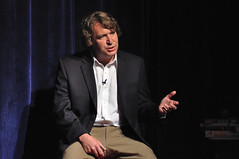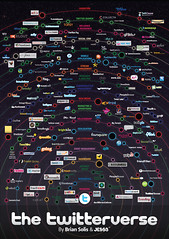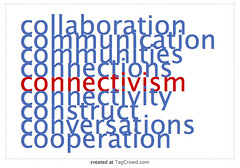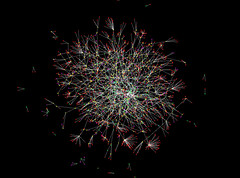I visited one of the sessions where Siemens was the speaker and I was very impressed by what he talked about; I do not think I had ever heard about connectivism before. I think the session was labelled workshop and Siemens soon invited the audience to discuss and ask questions.
I remember me having something I would like to ask but there was always a lot of other persons who either wanted to discuss something or just wanted to have a conversation with Siemens (when listened to by others). Particularly I noticed one person talking in a rather strange way although with whit and cleverness. Later I found out that it must have been Graham Attwell, whom I had not heard of before (picture below). However, I never had the opportunity to ask my question.
In any case Siemens made an impression on me and he also had a keynote at the conference as far as I can remember. Most impressive though, was a book by Siemens with strange illustrations which could be freely downloaded from the Internet. After having returned home I spent lots of hours reading this interesting book, often from pages wrinkled by sweat and steam in my sauna at home.
The document below is my compilation of pieces of text originally written by Siemens. Later I have been very interested in how to treat original documents. I have often argued that it is even harder to compile a document out of various sources than writing it myself. However, we might end up in a border zone between plagiarism and originality.
Interestingly, I have written very little of the text below although I have spent lots of hours reading, reflecting, selecting and finally compiling Siemens's words in a document that I very much think is my own understanding of the original. The question that I ask is: is it possible to use someone else's text and repurpose it like I have done here? My answer would be: Yes as long as I attribute it to the original creator George Siemens. Here it is Continual suspended certainty:
Interestingly, I have written very little of the text below although I have spent lots of hours reading, reflecting, selecting and finally compiling Siemens's words in a document that I very much think is my own understanding of the original. The question that I ask is: is it possible to use someone else's text and repurpose it like I have done here? My answer would be: Yes as long as I attribute it to the original creator George Siemens. Here it is Continual suspended certainty:
We have in the past seen knowledge as an object and learning as a product. But knowledge is really more of a stream and learning more of a process. A product is a stopped process—consider a book, building a car, a course, a training program, a marketing campaign. However these skills and processes that will make us people of tomorrow are not yet embedded in our educational structures. While there are many who are attempting new approaches, the vast majority are ensconced in structures, preparing students and employees for a future that will not exist.
Knowing and learning are today defined by connections. Connecting with people and content is a constant, ongoing, daily activity. Learning is a continual, network-forming process. This model is gaining prominence in both academic and corporate environments. As we encounter new resources (knowledge, people, and technology nodes), we may choose to actively connect and create our personal learning network.
Social tools are emerging which permit rapid exchange of knowledge, and high levels of dialogue. Communication can now occur collaboratively (wiki, online meetings), through individual broadcast (blogs, podcasts, video logs), and in shared spaces (social bookmarking). Knowledge, when buffeted by numerous forces and factors, is under constant scrutiny by the masses, continual suspended certainty. When we filter knowledge ourselves, on the other hand, we risk losing the serendipity of random encounters. The value of personal control may reduce diverse experiences beyond our intention. The “wisdom of crowds” only works when each member of the collective brings a unique perspective
Connectivism is the assertion that learning is primarily a network forming process. Networks are adaptive, fluid, and readily scale in size and scope. A hierarchy imposes structure, while networks reflect structure. We have a different relationship with knowledge that has been crystallized in the form of a book or a journal. Why do we respect it more?
Our metaphors of thought over the last century include: black box, computer, and mind as constructor of reality We do not always construct (which is high cognitive load), but we do constantly connect. We need to break false modes of thinking in relation to knowledge. Our mind is a network, an ecology. It adapts to the environment. Connectivism is a theory describing how learning happens in a digital age. Research in traditional learning theories comes from an era when networking technologies were not yet prominent.
How does learning change when knowledge growth is overwhelming and technology replaces many basic tasks we have previously performed? Traditional knowledge organization consisted of fairly static hierarchies and containers. Organization today consists of dynamic networks and ecologies—models capable of adaptation (adjusting and reacting to changes). Structure is the outgrowth of organization, not the pre-requisite to organization.
The act of knowing is offloaded onto the network itself. The connections that enable us to learn more are more important than our current state of knowing. We need to separate the learner from the knowledge they hold. It is not really as absurd as it sounds. Consider the tools and processes we currently use for learning. Courses are static, textbooks are written years before actual use, classrooms are available at set times, and so on.
Lars-Erik Jonsson











Inga kommentarer:
Skicka en kommentar